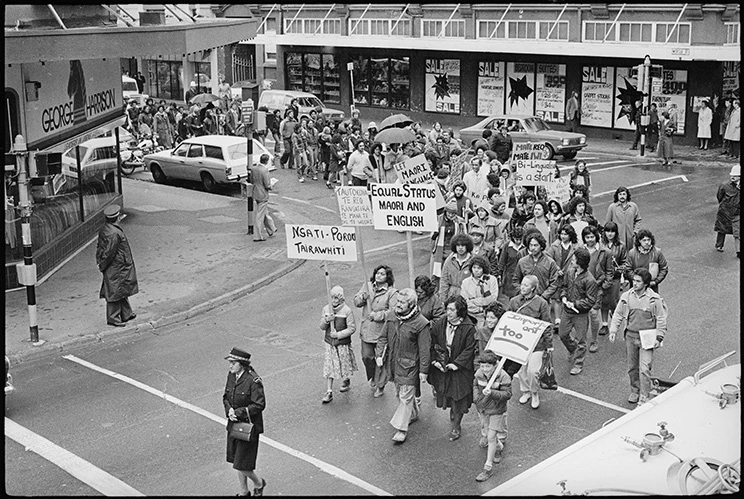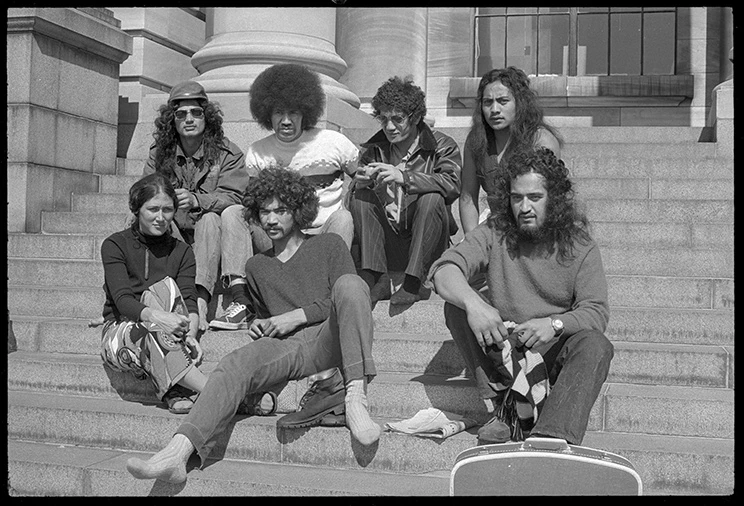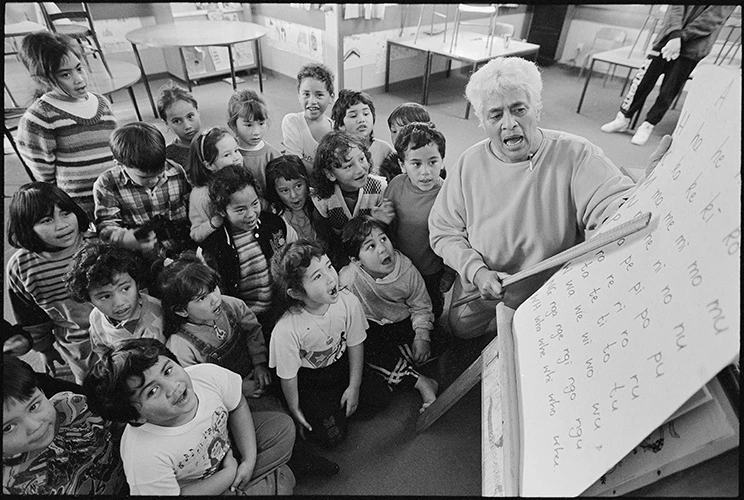Te Wiki o te Reo Māori — Māori Language Week in context
Te Wiki o te Reo Māori is celebrated in September. In this blog post, you'll find insights into the origins of Māori Language Week as well as inspiration and support for educators, librarians, and others wishing to start their Māori language journey.
Why is te reo Māori important?
Te reo Māori has never been acknowledged as anything more than a language. The history of Māori and Pākehā relationships in Aotearoa is a glaring reminder of this fact.
Why is te reo Māori important? Why should it be important to me as a New Zealander?
Te reo Māori is the key to understanding our past, our present, and our future as united peoples of Aotearoa. It is a living entity that draws its mauri or life force from the user. It opens the door to a different world that invites you to learn more about your connections to the taiao or environment and your place in the whakapapa or genealogy of the universe.
Te reo Māori will always have a place in Aotearoa. Te Wiki o te Reo Māori is an opportunity for all of us to think about how te reo Māori could have a place within our lives.
— Ruki Tobin, Poutiaki Rauemi, National Library Services to Schools

March on Parliament in support of equal status of the Māori language with English, 1 August 1980 by Dominion Post photographer. Ref: EP/1980/2470/20A-F Alexander Turnbull Library. Some rights reserved.
Tō tātou taonga te reo Māori — our treasure the Māori language
This whakatauākī from Sir James Hēnare articulates the connection to te reo Māori that is vital to tangata whenua.
Ko te reo te mauri o te mana Māori. Ko te kupu te mauri o te reo Māori. E rua ēnei wehenga kōrero e hāngai tonu ana ki runga i te reo Māori. Ko te reo, nō te Atua mai.The language is the life force of the mana Māori. The word is the life force of the language. These two ideas are crucial to the Māori language. A language that is a gift from God.
— Sir James Hēnare, 1911–1989
We are in a time of real transformation, where the discussion around who we are as people of Aotearoa, our understanding of our history, and our national identity are not only being debated at the dining table but also at the highest levels of government.
The Māori Language Petition (1972)
Mahuru, or September, is the month where we are encouraged to speak, promote, and celebrate te reo Māori.
Why September you may ask?
Te Reo Māori Day is on September 14th. This day celebrates and acknowledges the Māori Language Petition that was brought to Parliament in 1972 by Ngā Tamatoa and Te Reo Māori Society.
This was a nationwide petition, and over 30,000 signatures were collected. As a result, the Government introduced the teaching of te reo Māori in primary and secondary schools throughout the country. This was the beginning of a revitalisation that ultimately ensured the survival of te reo Māori.

Members of Nga Tamatoa on Parliament steps, 1972 by Evening Post photographer. Ref: EP/1972/5388/11a-F Alexander Turnbull Library. Some rights reserved.
Te Wiki o te Reo Māori (1975)
Three years after the petition was presented to parliament, Te Reo Māori Day expanded to a week.
Thus, the creation of Te Wiki o te Reo Māori.
Since 1975, Te Wiki o te Reo Māori has been celebrated as a major calendar event. Its inception has played an integral role in helping people engage with and learn the language.
The emergence of kaupapa Māori education (1980s)
The 1980s saw kaupapa Māori education established in the form of kōhanga reo for preschoolers, and kura kaupapa Māori for primary and secondary school students.
The first kōhanga reo opened in Wainuiomata in April 1982. Ngā Kōrero o Ipurangi o Aotearoa | NZHistory tells us:
The essence of Te Kōhanga Reo was to bring the elders who were fluent speakers together with their mokopuna, the preschool generation, and the parents, following the Māori model of whānau development.
Te Kura Kaupapa Māori o Hoani Waititi, the first kura kaupapa Māori, was established in West Auckland in 1985. Like many others, it continues to flourish today.
The principles of kura kaupapa Māori remain strong. In 2020, there were 294 Māori medium schools throughout Aotearoa, with 22,391 rangatahi enrolled, and a further 188,048 students learning te reo Māori in English medium schools.

Nan Bella teaching Māori at Waiwhetu School by Mark Coote, Evening Post, 1991. Ref: EP/1991/2155/3-F Alexander Turnbull Library. Some rights reserved.
Te reo Māori on radio (1920s) and television (1982)
While waiata Māori were heard on radio as early as the 1920s, the first television programme entirely in te reo Māori, Te Karere, was broadcast in 1982.
Learn more from Te Ara:
Te reo Māori recognised (1986) and an official language (1987)
In 1986, the Waitangi Tribunal recognised te reo Māori as a taonga (treasure).
A year later, it was made an official language of New Zealand.
Māori language claim — Ongoing work, 1980s to 2000s on Te Ara has more.
Mahuru Māori is born (2017)
Me kite, me ronga, me kōrero te reo Māori.
Let the Māori language be seen, be heard, be spoken.
In 2014, te reo expert Paraone Gloyne undertook a social experiment, the goal being to speak te reo Māori for an entire month. This gave birth to a new initiative, Mahuru Māori, that further expanded the ideals of Te Reo Māori Day and Te Wiki o te Reo Māori.
Mahuru Māori invites individuals to engage in a variety of challenges using te reo Māori in their daily lives. These range from speaking te reo for an hour a day, to using the language all day, every day, for the month of Mahuru.
Mahuru Māori challenges people and empowers them to be champions of te reo Māori — it's not too late to give it a go!
Where are we today?
The latest data from Tatauranga Aotearoa | Stats NZ tells us that one in six Māori can speak te reo. Those aged between 15 and 24, along with those over 55, are most likely to be able to speak the language.
There are also increasing numbers of Pākehā who are championing te reo Māori and helping the language to flourish in many communities and organisations throughout New Zealand.
Our ākonga, their whānau, and our communities are among our greatest resources for learning te reo Maori. There’s plenty of evidence to show that our rangatahi want to engage with the language, and more than that, they are passionate about it.
Watch these examples of students taking the lead in learning and teaching te reo Māori:
Grey Lynn Primary in Auckland (YouTube video, 2:34) has introduced te reo Māori lessons into their classrooms and the students are proud to be learning the language.
As seen in this Te Ao Māori news item, students can lead the way in teaching te reo Māori, reinforcing all-important tuakana-tēina relationships.
Finnian Galbraith (YouTube video, 7:35) was a year 11 student at Kāpiti College in 2015 when he wrote his speech: 'The importance of correctly pronouncing Māori words'.

People marching with banner in Te Wiki o te Reo Māori parade, Wellington, 2018 by Dylan Owen. All rights reserved. Used with permission.
Your te reo Māori journey
Will I be able to learn or teach te reo Māori? Where do I start? I need help!
Thoughts like these are common when taking those first steps in the journey of teaching or learning te reo Māori. These stories from New Zealanders who have taken that step and been empowered by their journey are a source of whakamanawa for us all — support, courage, and inspiration:
Also recommended as a great place to start your journey is Hēmi Kelly's reassuring and uplifting 2018 TEDx talk, Te reo Māori: A new era for the language (YouTube video, 11:52).
Supporting resources
Here are some rauemi for educators and librarians, as well as those wishing to embark on a personal te reo Māori journey. We've aimed to provide something useful for all learners, no matter where you're starting from.
National Library
Te reo Māori (Māori language) — AnyQuestions — help with finding information about the history of te reo Māori, as well as resources to develop te reo skills.
Other reliable resources
1000 Māori place names — NZHistory page to help you correctly pronounce Aotearoa place names.
History of the Māori language — an outline of the history of te reo Māori from NZHistory.
Māori language learning — an excellent range of resources to support the Te Whanake learning programme, including videos, podcasts, and animations.
Māori Language.net — Speak Māori is a language learning system that delivers accelerated learning of te reo Māori.
Multimedia story — Te mana o te reo Māori — a rich, engaging, and easy-to-read history of te reo Māori, tracing the journey from its inception, through colonisation and the struggles to keep the language alive, the revitalisation that began in the 1980s, to the present day.
ReoMāori from Te Taura Whiri i te Reo Māori | Māori Language Commission — history, resources, ideas, and events, including how to join the 14 September Māori Language Moment.
Te reo Māori — the Māori language — Te Ara story charting the history of te reo Māori.
Te reo Māori in English-medium schools — a range of resources including haka, waiata, lesson plans, and instructional texts for students in both primary and secondary schools from Te Kete Ipurangai (TKI).
Te reo Māori on RNZ — a collection of useful videos on a range of topics relating to te reo Māori, including pronunciation.
Te Wiki o te Reo Māori — articles, quizzes, events, and activity books to celebrate Te Wiki o te Reo Māori from Te Papa Tongarewa.
Apps to support learning
Aki — developed by the University of Otago, this app uses interactive games to teach te reo.
Drops: Maori language learning — easy to use for all ages and stages — 5 minutes of language immersion daily using sound and images, delivered via games and quizzes.
He aha tēnei? — What is this? — designed especially for kids. A drag and drop game that uses both letters and pictures.
Kawe Kōrero — developed by the Waikato Regional Council, this app is a great introduction to the language and basic protocols.
Kupu — like having a portable dictionary, this app uses the camera on your device to give the names of objects in te reo Māori.
Te reo Māori online courses
Poupou Huia Te Reo – Te Hōkairangi — Certificate in Tikanga and Māori Language for the Home and Community — Te Wānanga o Raukawa.
Te Reo Rangatira – Māori Language — Te Wānanga o Aotearoa.
Toro Mai — Massey University.
Kia kaha te reo Māori!
Honour the past, keep ourselves safe now and prepare for the future together!
— Māori Langauge Moment, 2020, Te Taura Whiri i te Reo Māori | Māori Language Commission
Aotearoa’s future will be a brighter one for us all when we hear our unique language all around us from the biggest cities to the smallest towns, and everywhere in between.
Kia kaha te reo Māori!
This blog post
This post was originally published in September 2020. It was updated with new information and resources, and republished in September 2021.